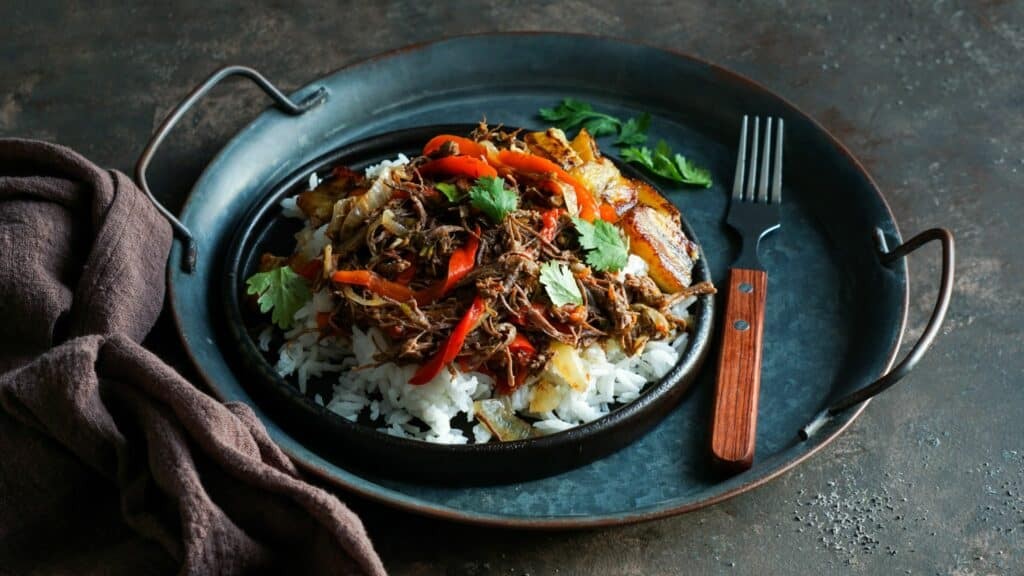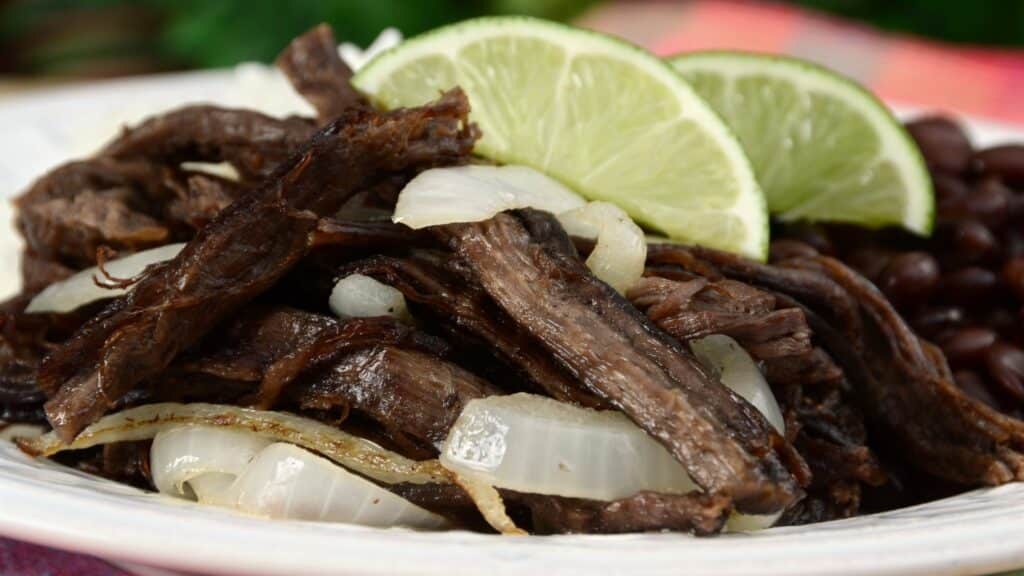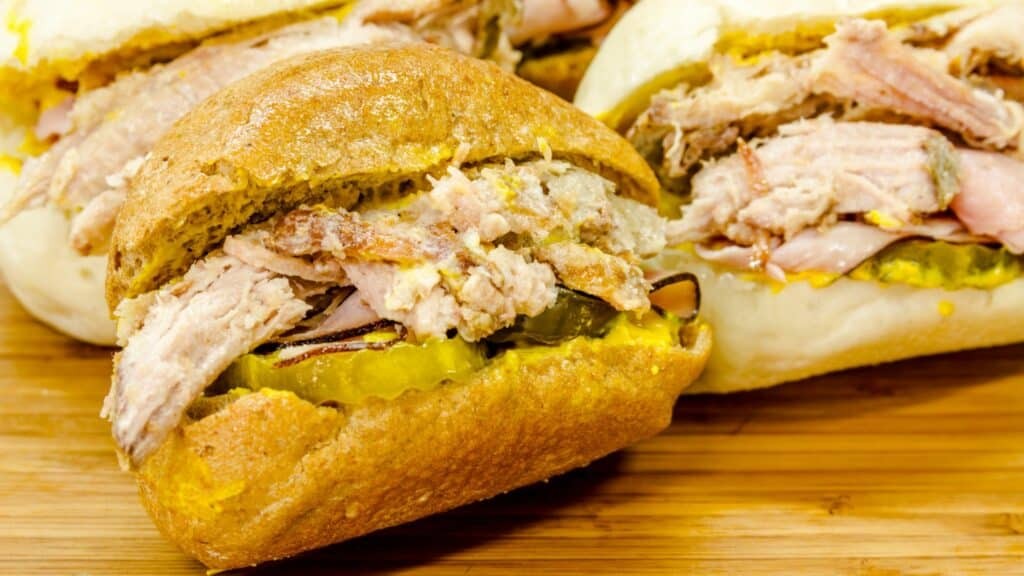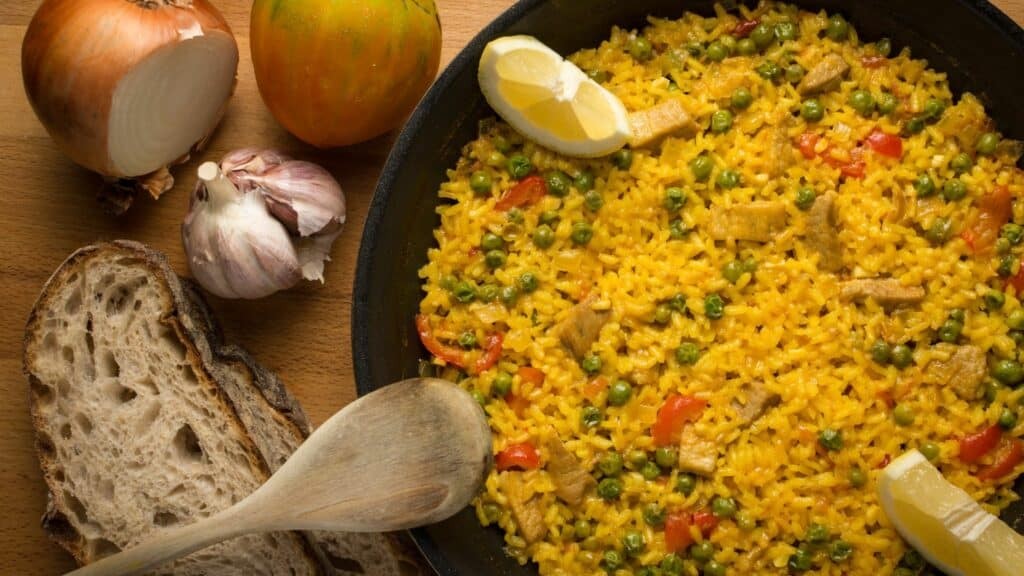Cuba’s culinary landscape is a vibrant tapestry woven with Spanish, African, and Caribbean influences, offering a diverse range of delectable dishes; FOODS.EDU.VN unveils the secrets behind the island’s most beloved food. Discover the most popular food in Cuba, its rich history, cultural significance, and how to prepare it, plus other culinary delights that capture the heart of Cuban cuisine.
1. Unveiling the Culinary Heart of Cuba: What is the Most Popular Food in Cuba?
The most popular food in Cuba is undoubtedly Ropa Vieja. This iconic dish features shredded beef simmered in a rich tomato-based sauce with peppers, onions, and spices, embodying the island’s culinary heritage. It reflects the country’s history and resourceful cooking techniques, becoming a symbol of Cuban gastronomy.
1.1. Diving Deeper into Ropa Vieja: The Essence of Cuban Cuisine
Ropa Vieja, translating to “old clothes,” is more than just a meal; it’s a reflection of Cuban history and resourcefulness. Traditionally, the dish utilizes tougher cuts of beef, slow-cooked until tender and shredded, resembling rags, which is how it earned its name. The savory tomato sauce, infused with local spices, elevates the dish, offering a taste of Cuban soul.
1.2. What Makes Ropa Vieja the Most Popular Food in Cuba?
Several factors contribute to Ropa Vieja’s popularity:
- Historical Significance: It represents Cuba’s colonial past and the blending of cultures that shaped its cuisine.
- Flavor Profile: The combination of tender beef and savory sauce appeals to a wide range of palates.
- Versatility: It can be enjoyed with various sides, such as rice, beans, and plantains, making it a complete and satisfying meal.
- Accessibility: The dish can be found in paladares (family-run restaurants) and upscale establishments, making it accessible to everyone.
1.3. The Origins and Cultural Significance of Ropa Vieja
The history of Ropa Vieja is as rich and flavorful as the dish itself. Its roots trace back to the Sephardic Jews of the Iberian Peninsula, who prepared it as a Sabbath meal. The dish traveled to Cuba with Spanish colonists and became a staple in Cuban homes.
1.4. A Legend Woven into the Recipe
A captivating legend surrounds Ropa Vieja, telling the tale of a poor man who couldn’t afford to feed his family. In desperation, he shredded his old clothes and cooked them, praying for a miracle. As the clothes simmered, they transformed into a delicious meat stew, symbolizing hope and resilience.
1.5. Serving Suggestions and Variations
Ropa Vieja is typically served with congri (Cuban black beans and rice) and fried plantains. However, variations exist throughout the island, with some cooks adding potatoes, bell peppers, or olives to the stew.
2. Beyond Ropa Vieja: Exploring Other Culinary Delights in Cuba
While Ropa Vieja reigns supreme, Cuba offers a diverse culinary landscape worth exploring. From crispy fried pork to flavorful rice dishes, each dish tells a unique story of the island’s past and present.
2.1. Vaca Frita: Crispy, Savory, and Irresistible
Vaca Frita, meaning “fried cow,” is another popular Cuban dish featuring shredded beef marinated and then pan-fried until crispy. The result is a flavorful and satisfying dish with a delightful textural contrast. The dish is believed to have originated in the Canary Islands, where slaves transformed tough cuts of meat into delicious meals.
2.2. Tostones: A Plantain Lover’s Dream
Tostones are twice-fried plantain slices, a staple in Cuban cuisine. These crispy and savory snacks are often served with mojo, a garlic-citrus dipping sauce. Plantains, originally from Southeast Asia, were brought to the Caribbean by Spanish settlers and have become an integral part of Cuban cuisine. Cubans often use the term aplatanado (being “plantain-like”) to describe non-native islanders who have adopted the country’s customs and culture.
2.3. Arroz con Pollo: A Flavorful Rice and Chicken Dish
Arroz con Pollo, similar to Spanish paella, is a comforting dish made with rice, chicken, tomato sauce, and sofrito (a traditional Cuban seasoning). The origins of this recipe stem from the time of the Moors occupation of Spain, which began in the 8th century. Later, the Spanish brought it to Latin America, including Cuba, where locals put their own spin on the dish.
2.4. Moros y Cristianos: A Symbolic Rice and Beans Dish
Moros y Cristianos, meaning “Moors and Christians,” is Cuba’s version of rice and beans. Black beans (Moros) and white rice (Cristianos) are cooked together in the same pot with sofrito, creating a flavorful and symbolic dish. The name is a reference to the historical conflict between the Moors and Christians in Spain.
2.5. Medianoche: The Midnight Sandwich
Medianoche, meaning “midnight,” is a popular sandwich served in Havana’s nightclubs. It features roast pork, ham, Swiss cheese, pickles, and mustard on a sweet egg roll. The sandwich is similar to the Cuban sandwich but uses a different type of bread.
2.6. Picadillo: A Versatile Ground Meat Dish
Picadillo is a flavorful ground meat dish with tomatoes, olives, capers, and raisins. It is often served with rice and beans or used as a filling for empanadas. The word picadillo derives from picar, meaning “to mince” or “chop.”
2.7. Fricase de Pollo: A Flavorful Chicken Stew
Fricase de Pollo is a chicken stew with dark meat, potatoes, tomato sauce, sour orange juice, and garlic. Fricassee is actually a French dish of meat or vegetables browned in butter, stewed in stock, and served in a white wine sauce. It’s believed that French refugees arriving in Haiti in the 1800s brought it with them. Many of them eventually resettled in Cuba, making fricase de pollo part of the local lexicon.
2.8. Cuban Coffee: A Sweet and Strong Pick-Me-Up
Cuban coffee, also known as Café Cubano, is a strong and sweet espresso made with natural brown sugar. It is a popular social activity in Cuba, enjoyed in cafeterias, bars, and homes.
2.9. Flan: A Classic Cuban Dessert
Flan is a creamy custard dessert with caramel topping, popular throughout Latin America. The Cuban version uses condensed and evaporated milk, resulting in a thicker and sweeter custard. Oddly, flan originated as a savory dish in ancient Rome. Eventually, a chef created a sweetened version with honey, and the dish became hugely popular. The Spanish later adopted the recipe and added their own twist. Like most other foods, they then brought it with them to the Caribbean.
3. How to Make Ropa Vieja: A Step-by-Step Guide
Craving a taste of Cuba? Here’s how to make Ropa Vieja at home, adapted from FOODS.EDU.VN:
3.1. Gathering Your Ingredients
- 2 pounds beef brisket or flank steak
- 1 tablespoon olive oil
- 1 large onion, chopped
- 2 bell peppers (red and green), chopped
- 4 cloves garlic, minced
- 1 (28 ounce) can crushed tomatoes
- 1 cup beef broth
- 1/2 cup dry red wine (optional)
- 1/4 cup tomato paste
- 1/4 cup green olives, stuffed with pimentos, sliced
- 2 tablespoons capers
- 1 teaspoon ground cumin
- 1 teaspoon dried oregano
- 1/2 teaspoon salt
- 1/4 teaspoon black pepper
- 2 bay leaves
- Chopped cilantro, for garnish
3.2. Preparing the Beef
- Place the beef in a large pot and cover with water. Bring to a boil, then reduce heat and simmer for 2-3 hours, or until the beef is very tender.
- Remove the beef from the pot and let it cool slightly. Shred the beef using two forks.
3.3. Making the Sofrito
- Heat the olive oil in a large skillet over medium heat. Add the onion and bell peppers and cook until softened, about 5-7 minutes.
- Add the garlic and cook for 1 minute more.
3.4. Simmering the Stew
- Add the crushed tomatoes, beef broth, red wine (if using), tomato paste, olives, capers, cumin, oregano, salt, pepper, and bay leaves to the skillet. Bring to a simmer and cook for 15-20 minutes, or until the sauce has thickened slightly.
- Add the shredded beef to the skillet and stir to combine. Cook for another 10-15 minutes, or until the beef is heated through and the flavors have melded.
3.5. Serving and Garnishing
- Remove the bay leaves before serving.
- Garnish with chopped cilantro.
- Serve with congri (Cuban black beans and rice) and fried plantains.
Nutritional Information (per serving, approximate):
| Nutrient | Amount |
|---|---|
| Calories | 450 |
| Protein | 40g |
| Fat | 20g |
| Carbohydrates | 25g |




3.6. Tips for the Perfect Ropa Vieja
- Use a tough cut of beef like brisket or flank steak for the most authentic flavor.
- Don’t skimp on the sofrito, as it’s the base of the dish’s flavor.
- Slow-cooking the beef is essential for tenderness.
- Adjust the seasonings to your liking.
- Serve with your favorite Cuban sides.
4. The Cultural Significance of Cuban Cuisine
Cuban cuisine is more than just food; it’s a reflection of the island’s history, culture, and people. The blending of Spanish, African, and Caribbean influences has created a unique and flavorful culinary landscape.
4.1. The Influence of Spanish Cuisine
Spanish colonists brought many ingredients and cooking techniques to Cuba, including beef, pork, rice, and beans. Dishes like Arroz con Pollo and Flan are derived from Spanish cuisine.
4.2. The Impact of African Flavors
African slaves introduced ingredients like plantains, okra, and yams to Cuba. They also contributed cooking techniques like slow-cooking and using spices.
4.3. The Caribbean Touch
Cuban cuisine also incorporates Caribbean ingredients like tropical fruits, seafood, and peppers. This influence adds a vibrant and fresh element to the island’s food.
4.4. Cuban Food as a Symbol of Identity
Cuban food is a source of pride and identity for Cubans. It is often associated with family gatherings, celebrations, and traditions. Sharing a meal is an important part of Cuban culture, fostering a sense of community and connection.
5. Exploring Cuban Cuisine in the United States
While traveling to Cuba may not be possible for everyone, you can still experience the flavors of the island in the United States. Many Cuban restaurants can be found in cities with large Cuban populations, such as Miami and New York City.
5.1. Finding Authentic Cuban Restaurants
When seeking authentic Cuban cuisine in the United States, consider these tips:
- Look for restaurants with Cuban chefs and staff.
- Read online reviews to get a sense of the restaurant’s authenticity.
- Ask locals for recommendations.
- Try dishes that are not commonly found on other Latin American menus.
5.2. Cuban Food Festivals and Events
Many cities host Cuban food festivals and events, offering a great opportunity to sample various dishes and learn about Cuban culture. Check local listings for events in your area.
5.3. Cooking Cuban Food at Home
With the help of cookbooks and online resources, you can easily prepare Cuban dishes at home. FOODS.EDU.VN offers a variety of Cuban recipes that you can try.
6. The Future of Cuban Cuisine
Cuban cuisine is constantly evolving, with chefs experimenting with new ingredients and techniques. However, the traditional flavors and dishes remain an essential part of the island’s culinary identity.
6.1. Modern Interpretations of Classic Dishes
Some Cuban chefs are creating modern interpretations of classic dishes, using innovative techniques and presentations. This allows them to showcase the flavors of Cuban cuisine in a new and exciting way.
6.2. The Growing Popularity of Cuban Food
Cuban food is becoming increasingly popular worldwide, with restaurants opening in major cities around the globe. This trend is a testament to the deliciousness and cultural significance of Cuban cuisine.
6.3. Sustainable and Local Ingredients
Some Cuban chefs are committed to using sustainable and local ingredients in their cooking. This helps to support local farmers and preserve the environment.
7. Essential Ingredients in Cuban Cooking
To embark on your Cuban culinary adventure, familiarize yourself with these essential ingredients:
7.1. Sofrito
This aromatic base of garlic, onions, and bell peppers is the foundation of many Cuban dishes. It infuses dishes with a deep, savory flavor.
7.2. Garlic
Garlic is a staple in Cuban cooking, used in everything from sauces to marinades. It adds a pungent and flavorful kick to dishes.
7.3. Cumin
This warm and earthy spice is used to season meats, beans, and rice. It is a key ingredient in dishes like Ropa Vieja and Picadillo.
7.4. Oregano
Dried oregano adds a slightly bitter and herbaceous flavor to Cuban dishes. It is often used in combination with cumin and garlic.
7.5. Sour Orange
Sour orange juice, also known as naranja agria, is used to marinate meats and add a tangy flavor to sauces. If sour orange is unavailable, you can substitute a mixture of orange juice and lime juice.
7.6. Plantains
These starchy, banana-like fruits are a staple in Cuban cuisine. They can be fried, boiled, or mashed and are often served as a side dish.
7.7. Black Beans
Black beans are a staple in Cuban cuisine, often served with rice or as a side dish. They are a good source of protein and fiber.
7.8. Rice
Rice is a staple in Cuban cuisine, often served with beans, meat, or vegetables. It is a versatile and filling grain.
7.9. Olive Oil
Olive oil is used for cooking and drizzling over dishes. It adds a rich and flavorful element to Cuban cuisine.
8. Cuban Drinks: More Than Just Mojitos
While mojitos are a popular Cuban cocktail, the island offers a variety of other refreshing and flavorful drinks.
8.1. Cuban Coffee (Café Cubano)
As mentioned earlier, Cuban coffee is a must-try. This strong and sweet espresso is a popular way to start the day or enjoy an afternoon pick-me-up.
8.2. Guarapo
Guarapo is a refreshing sugarcane juice, often sold by street vendors. It is a sweet and natural drink perfect for a hot day.
8.3. Materva
Materva is a popular Cuban soda made with yerba mate. It has a slightly bitter and herbal flavor.
8.4. Ironbeer
Ironbeer is another popular Cuban soda with a unique and slightly metallic flavor. It is often described as a combination of bubblegum and cream soda.
8.5. Cuban Rum
Cuban rum is world-renowned for its quality and flavor. It is used in many cocktails, including mojitos, daiquiris, and Cuba Libres.
9. Famous Cuban Chefs and Food Personalities
Cuban cuisine has been shaped by the talent and passion of many chefs and food personalities.
9.1. Nitza Villapol
Nitza Villapol was a Cuban chef and television personality who is considered a pioneer of Cuban cuisine. She hosted a popular cooking show for over 40 years and wrote several cookbooks.
9.2. Maricel Presilla
Maricel Presilla is a Cuban-American chef, restaurateur, and cookbook author. She is known for her expertise in Latin American cuisine and her commitment to using sustainable ingredients.
9.3. Douglas Rodriguez
Douglas Rodriguez is a Cuban-American chef who is considered a pioneer of Nuevo Latino cuisine. He is known for his innovative and creative dishes.
10. Frequently Asked Questions (FAQs) About Cuban Food
Here are some frequently asked questions about Cuban food:
10.1. What is the most popular food in Cuba?
Ropa Vieja, shredded beef in tomato sauce, is widely considered the most popular dish in Cuba.
10.2. What are some other popular Cuban dishes?
Other popular dishes include Vaca Frita, Tostones, Arroz con Pollo, and Moros y Cristianos.
10.3. What are the main influences on Cuban cuisine?
Cuban cuisine is influenced by Spanish, African, and Caribbean flavors.
10.4. What are some essential ingredients in Cuban cooking?
Essential ingredients include sofrito, garlic, cumin, oregano, sour orange, plantains, black beans, and rice.
10.5. Where can I find authentic Cuban food in the United States?
You can find authentic Cuban food in cities with large Cuban populations, such as Miami and New York City.
10.6. What is Cuban coffee?
Cuban coffee, or Café Cubano, is a strong and sweet espresso made with natural brown sugar.
10.7. What is a paladar?
A paladar is a family-run restaurant in Cuba, often located in a private home.
10.8. What is sofrito?
Sofrito is a traditional Cuban seasoning made with garlic, onions, and bell peppers.
10.9. What is congri?
Congri is a Cuban dish made with black beans and rice cooked together.
10.10. What is the difference between a Cuban sandwich and a Medianoche?
Both sandwiches contain similar ingredients, but a Cuban sandwich is made with crusty Cuban bread, while a Medianoche is made with a sweet egg roll.
Cuban cuisine offers a delightful and diverse range of flavors and dishes, reflecting the island’s rich history and culture. From the iconic Ropa Vieja to the refreshing Guarapo, there’s something for everyone to enjoy. Whether you’re exploring Cuban restaurants in the United States or cooking Cuban food at home, FOODS.EDU.VN is your ultimate guide to discovering the culinary treasures of Cuba.
Hungry for more authentic Cuban recipes and culinary insights? Visit FOODS.EDU.VN today and unlock a world of flavor!
Contact us:
Address: 1946 Campus Dr, Hyde Park, NY 12538, United States
Whatsapp: +1 845-452-9600
Website: foods.edu.vn